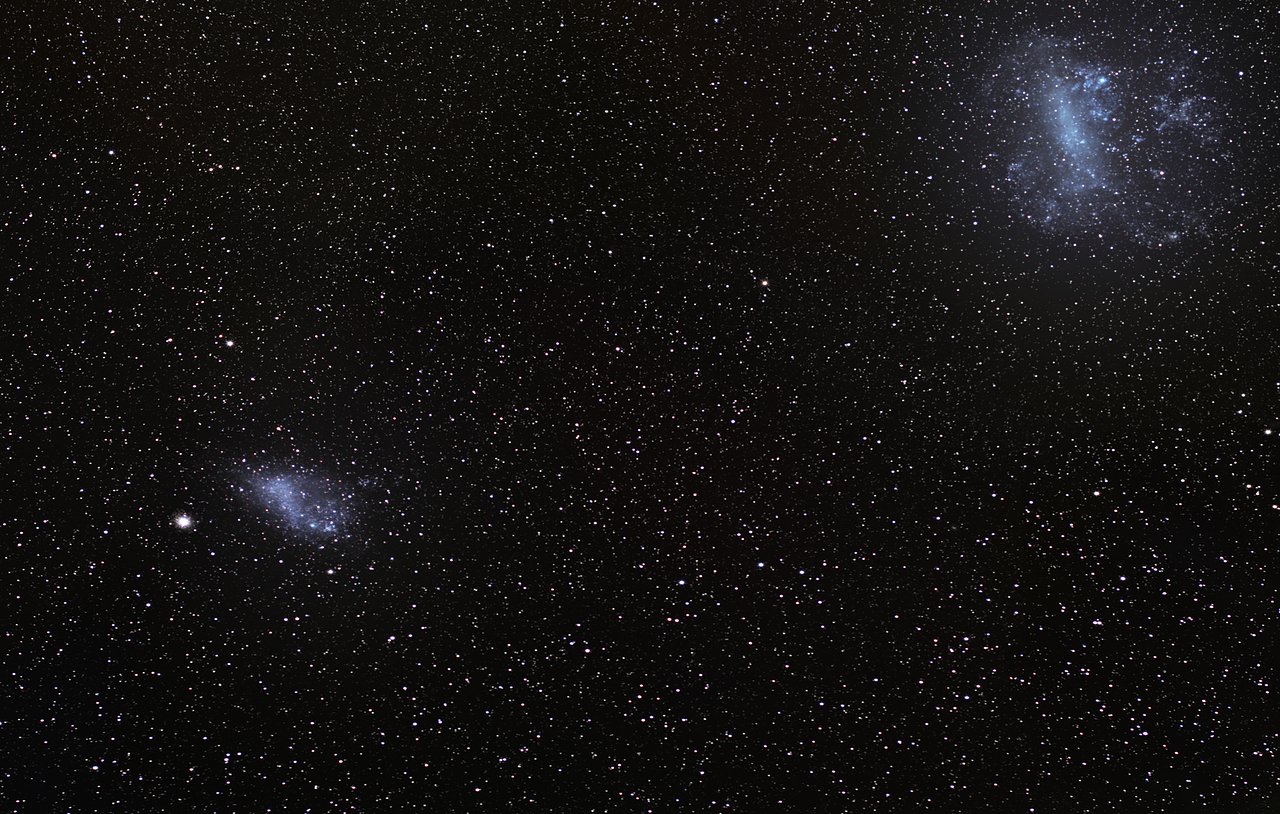- What “chemical clocks” are and how they can be used to measure the ages of the stars
- Why figuring out stellar ages is more complex than we previously thought
- What we can learn through measuring the ages of individual stars in the Milky Way and beyond
Q. Firstly, what exactly do you mean when you talk about “chemical clocks”?
Giada Casali (GC): When we talk about chemical clocks, we are referring to the ratios between particular pairs of elements — called chemical abundance ratios — in a star, that display a strong dependence on age. Every star is made up of lots of different elements that are produced in different processes and at different time scales, which is why we can use them as an innovative way to measure a star’s age.
Laura Magrini (LM): For example, massive stars produce some elements quickly, whereas smaller stars produce them more slowly. So in theory, by looking at the spectrum of light from a star and measuring the abundance ratio between an element produced very quickly (when the Galaxy was very young) and an element produced much more slowly (and therefore only produced recently), we have a sort of track of when a star formed, and can therefore predict its age. Using stars located very close to the Sun, astronomers have discovered relations between age and some specific age-dependent abundance ratios. But we wanted to know: Are these relations universal? Can they be applied to all the stars in our Galaxy?
Q. Could you summarise what you found in this research ?
LM: Our idea, matured with Lorenzo Spina at Monash University in Australia, was to use archival data from the HARPS instrument on the ESO 3.6-metre telescope to measure specific chemical clocks in stars similar to the Sun, but with different abundances of elements heavier than helium and hydrogen. When we say “similar to the Sun”, we mean stars with very similar surface temperature and surface gravity and we call them solar-like stars; selecting such stars means that any variation in their spectrum of light is due to differences in chemical abundances, which we can presume are related only to their age.
GC: We compared the ages of the solar-like stars, calculated due to their very well-known properties, with the ratios of specific elements, for example yttrium to magnesium, which is particularly strongly dependent on age. We were expecting to be able to apply our relation everywhere, but when we looked at the yttrium to magnesium ratio in stars further away from the Sun, in the direction of the Galactic centre, we found less yttrium than we would expect to find in stars of the same age close to the Sun. This means that this specific chemical clock relationship doesn’t apply in the same way everywhere in the Milky Way!
Q. Were you surprised by this discovery?
LM: Absolutely! Previous studies gave us hope that there may be a universal relationship between chemical clocks and age for solar-like stars throughout the Milky Way, but we found that this relationship can’t be applied everywhere. We think the difference arises because the stars didn’t all form at the same time, rather the Galaxy formed “inside out”, with the inner parts forming the quickest. This means that the star formation process varies throughout the Galaxy and the contribution of low and high mass stars with varying amounts of heavy elements is different in different places and at different epochs.

Q. So why did you decide to carry out this research in the first place?
GC: We wanted to investigate another method to date stars. Determining stellar ages is really important for astronomers to understand how the Milky Way formed and evolved, but it’s actually one of the most difficult parts of astrophysics. The most common technique used at the moment is called isochrone fitting; this technique compares the observed colours and brightnesses of stars with the expected ones from theoretical predictions, and from that comparison it infers the ages of the stars.
The technique works very well for groups of stars all of the same age, for example members of star clusters. However, it is very difficult to use it to date individual stars, unless their properties are particularly well known. For solar-like stars, we do know their properties, so we can calibrate the new chemical clock method with the isochrone fitting method to find a new way to date stars with unknown properties.
LM: Our idea was to find a universal relation, valid across the entire Milky Way, that would allow us to measure stellar ages simply by measuring their chemical composition…but life is always more complicated! In the past, we looked specifically at the abundance between carbon and nitrogen, which is a very effective method of figuring out the ages of giant stars. We found that since this abundance ratio essentially depends on stellar evolution, it is effectively valid across the entire Galactic disc, while it can vary, for instance, in the Galactic halo.
Our ultimate aim is to collect different chemical relations for many stars that we know the ages of. The Gaia-ESO survey — which we used for both pieces of research — is the largest public spectroscopic survey (it used the Very Large Telescope (VLT) for over 300 nights!) carried out on an eight-metre-diameter telescope. It provides the most accurate database of detailed chemical abundances in stars across all the components of the Galaxy, and is also the only one focusing on star clusters, sampling all stars from young to old. The Gaia-ESO survey, therefore, is a fundamental tool for our research.
Q. What are the implications of this discovery?
LM: The result means that astronomers need to be more careful when they are trying to work out the ages of stars, as it is not as simple as we had previously assumed. We applied the relationships we found for different pairs of chemical elements in the HARPS data for nearby stars to open star clusters observed in the Gaia-ESO survey, and found that our relationship, built for the solar neighbourhood, does not correctly calculate the ages of stars in clusters in the Milky Way’s inner disc, where star formation and evolution happens much faster.
We know that the Milky Way is made up of two discs of stars — one thin and one thick. Recent results from the European Space Agency’s Gaia satellite show that the thick disc probably formed through the interaction of the Milky Way with another galaxy several billion years ago, and that the stars in each disc have different ages. It is known that the stars in the thick disc contain much more magnesium than iron, for example, suggesting a different star formation history. Using our chemical clock relations, we were able to confirm the difference in ages of the two discs for stars located close to the Sun.

Q. Why do you think is it important to measure the ages of stars and understand the formation and the evolution of the Milky Way?
LM: The only place that we can measure the ages of individual stars so precisely is the Milky Way. So by investigating these stars in more detail, we can better understand spiral galaxies, which are among the most common — and for me the most beautiful — type of galaxies in the Universe. As the luminous part of the Universe, galaxies are our “window” to understanding the Universe’s evolution; they are vital for understanding how it formed and evolved, and what its future could hold.
Q. Do you plan to follow up this research in any way?
GC: We want to dig deeper into the relationship between various chemical abundance ratios and distance from the centre of the Milky Way using open star clusters as a calibrator. In particular we will continue to use data from the Gaia-ESO survey and APOGEE.
LM: In just a few years, the Extremely Large Telescope (ELT) will be up and running, and will allow us to resolve stars — and obtain their individual light spectra — in other galaxies with a similar detail to what we can now achieve only in the Milky Way. The ELT will be able to look at individual stars in other galaxies in our Local Group, and in the Virgo cluster of galaxies, so that we can measure their chemical composition and extend our studies to different environments.
Links
Biography Giada Casali and Laura Magrini
Giada Casali is a PhD student in her final year at the University of Florence/INAF-Astrophysical Observatory of Arcetri (Italy). She obtained her bachelor’s and master’s degrees at the University of Pisa (Italy). Giada has been working in the field of galactic archaeology, combining data collected by the European Space Agency’s Gaia satellite and ground-based large spectroscopic surveys. Her expertise mainly focuses on stellar spectroscopy and the determination of stellar ages.
Laura Magrini obtained her PhD in 2003 at the University of Florence (Italy), in collaboration with the Instituto de Astronomía de Canarias (Spain). After several postdoctoral positions in the field of galactic archaeology, since 2012 she has worked as a researcher at the INAF-Astrophysical Observatory of Arcetri. She works on galaxy formation and evolution, using spectroscopic data of stellar populations in the Milky Way and nearby galaxies.




